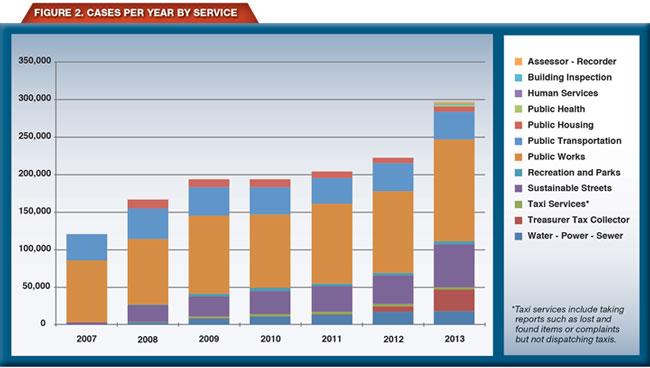Taking Service to the Next Level With 311
This month Western City focuses on technology and how cities are using it to enhance public service and engage the community. In San Francisco, we offer a 311 Customer Service Center that residents, businesses and visitors can access in a variety of ways — online, through mobile applications or with a phone call.
The 311 Customer Service Center operates 24 hours a day, 365 days a year to provide access to City and County of San Francisco government information and services. The goal is to assist callers with questions or requests for service at the time of the call. Less than 5 percent of the center’s overall call volume results in a caller being transferred to another department for an answer.
The 311 customer service representatives (CSRs) use the system to easily access information needed to answer the most frequently asked questions. The 311 service uses a customer relationship management system to facilitate:
- Easy placement of customer orders for city services;
- Efficient routing of those requests to the appropriate department; and
- Tracking and reporting on those requests.
The center was launched in March 2007 and answered its 16 millionth call on March 4, 2014.
How It Works
Call center. The CSRs answer calls for general information and take service requests in more than 170 languages. A total of 65 staff the phones, including CSRs who are certified bilingual for Spanish and Cantonese. The city contracts with a translation service for other languages, and the 311 call center uses this service. The call center also employs six CSR supervisors and 14 administrative support staff, plus a group of five to 10 as-needed employees.
Online services. Information about city services is available on the 311 website and spans a range from birth certificates and local events to housing and parking meters. The user can request services from menu items that include animals and pets, building and construction, business, community, parks, streets and sidewalks, garbage and graffiti, transportation, utilities and other city services. Users can also submit service requests via a self-service portal on the website and through Facebook and Twitter.
Mobile services. The 311 center’s mobile applications allow users to quickly and easily report issues by sending pictures, a brief description and a map-based location. The SF311 Mobile App provides current request status and sends a notification upon completion. In addition to the SF311 Mobile App, the system also includes the Open311 application programming interface, which is a platform that allows outside developers to create apps for the 311 system. Users can access Open311 apps created specifically for their particular mobile device. This feature is located on the website under “Contact Us.”
Enterprise reporting and open data. The 311 system manages the information that it collects through all of its contacts and consolidates it into organized and informative reports for city agencies as well as the Mayor’s Office, the board of supervisors and any member of the public or press who requests information. The 311 service requests are published to San Francisco’s Open Data Portal.
Service hub integrates requests. Many city agencies have applications optimized for their specific work. The service hub enables city departments, including public works, the municipal transportation agency and the water, power and sewer agency — as well as contracted city maintenance agencies — to exchange requests electronically and complete the requests in their own system. This eliminates the need to train department users on additional systems, simplifies work routing, eliminates the need for faxed requests and provides capacity for tracking and accountability. In essence, the service hub makes 311 the repository of most service requests, allowing various departments to pick up 311 requests and route them through their own department. Anyone doing business with the city can use the system to track requests.
Funding. The costs of the 311 service are paid through a mix of the General Fund and the enterprise funds of some municipal departments.
Marketing and building awareness. When San Francisco first launched the 311 center, the service was promoted extensively through the use of street banners, ads and promotions at bus stop shelters. Now in its eighth year, the 311 service benefits from widespread word of mouth, and virtually every city department references and links to 311. Occasionally a 311 representative will attend a neighborhood meeting to speak about the service if the requesting group includes a large number of people. Brochures explaining the service are also available.
Key Facts and Statistics
As Figure 1 indicates, the service has seen a significant increase in self-reporting using the Open311 apps during the first half of FY 2013–14.
Figure 2 (below) shows the number of cases per year for each service category. The chart reflects how the 311 service has changed and expanded since its inception.
Tips for Cities Seeking to Launch Similar Efforts
If your city is considering a 311 service, keep the following points in mind.
- The support of local elected officials is essential.
- Every department should have a 311 designated liaison to assist with questions and/or explain business processes.
- Simple can be better. Avoid the common desire of trying to automate 100 percent of the processes. Allowing for some manual intervention can greatly reduce complexity. Work collaboratively with all departments to address their concerns prior to taking on any new processes. A 311 customer service representative can be courteous and professional but if the reported pothole doesn’t get fixed, 311 will be blamed.
- Don’t become a switchboard. The value of 311 comes from being able to address each caller’s questions and issues at the time of the call.
- Establish a quality assurance process to ensure adherence and customer satisfaction.
- Don’t skimp on training. This applies to 311 customer service representatives as well as other agencies’ staff who will also need to learn the system to manage the requests.
- Don’t announce a launch date until staff is fully trained and the system has been tested and is ready to go. If the center is not successful from inception, people will say it has failed — and you may not get a second chance.
- Maximize your reporting capabilities to build in transparency and accountability and add value to the center.
For more information, visit www.SF311.org.
Photo credit: Arthit Kaeoratanapattama/Shutterstock.com
This article appears in the June 2014 issue of Western
City
Did you like what you read here? Subscribe to Western City




